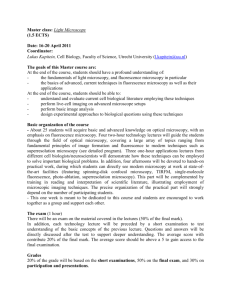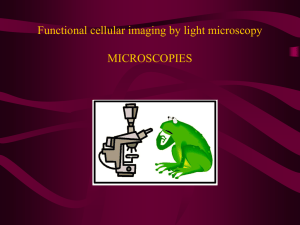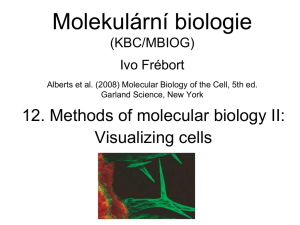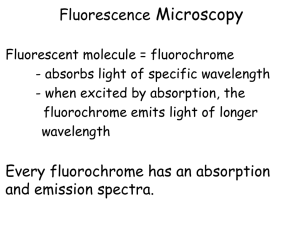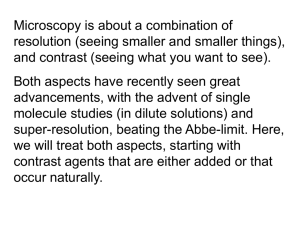Here - University of Warwick
advertisement
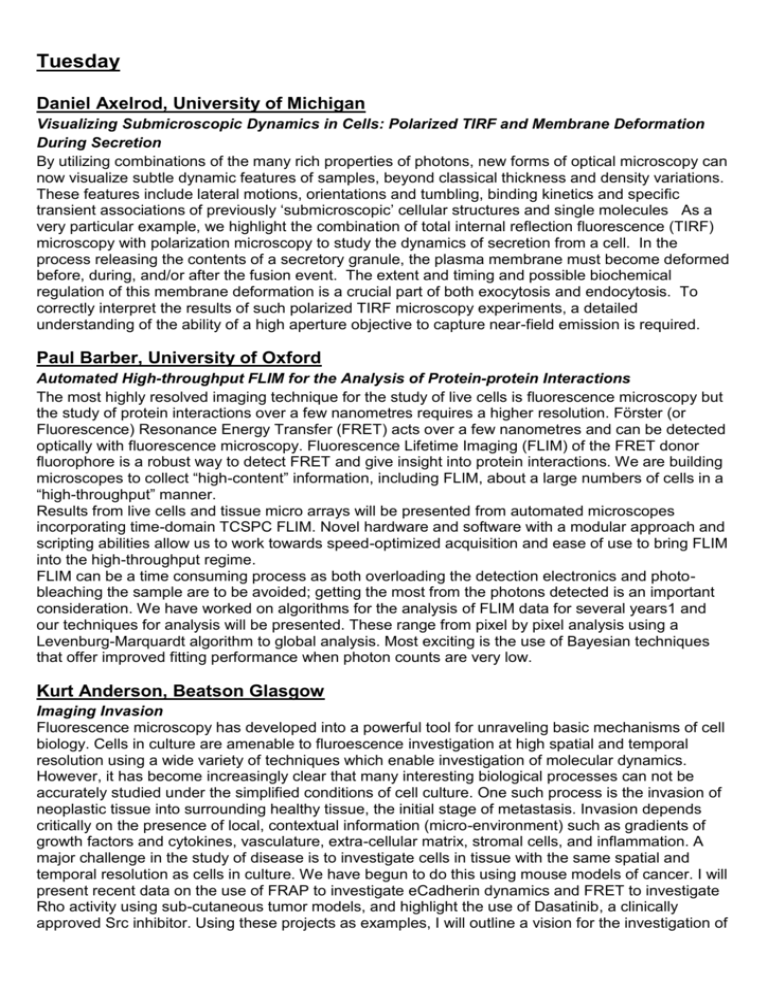
Tuesday Daniel Axelrod, University of Michigan Visualizing Submicroscopic Dynamics in Cells: Polarized TIRF and Membrane Deformation During Secretion By utilizing combinations of the many rich properties of photons, new forms of optical microscopy can now visualize subtle dynamic features of samples, beyond classical thickness and density variations. These features include lateral motions, orientations and tumbling, binding kinetics and specific transient associations of previously ‘submicroscopic’ cellular structures and single molecules As a very particular example, we highlight the combination of total internal reflection fluorescence (TIRF) microscopy with polarization microscopy to study the dynamics of secretion from a cell. In the process releasing the contents of a secretory granule, the plasma membrane must become deformed before, during, and/or after the fusion event. The extent and timing and possible biochemical regulation of this membrane deformation is a crucial part of both exocytosis and endocytosis. To correctly interpret the results of such polarized TIRF microscopy experiments, a detailed understanding of the ability of a high aperture objective to capture near-field emission is required. Paul Barber, University of Oxford Automated High-throughput FLIM for the Analysis of Protein-protein Interactions The most highly resolved imaging technique for the study of live cells is fluorescence microscopy but the study of protein interactions over a few nanometres requires a higher resolution. Förster (or Fluorescence) Resonance Energy Transfer (FRET) acts over a few nanometres and can be detected optically with fluorescence microscopy. Fluorescence Lifetime Imaging (FLIM) of the FRET donor fluorophore is a robust way to detect FRET and give insight into protein interactions. We are building microscopes to collect “high-content” information, including FLIM, about a large numbers of cells in a “high-throughput” manner. Results from live cells and tissue micro arrays will be presented from automated microscopes incorporating time-domain TCSPC FLIM. Novel hardware and software with a modular approach and scripting abilities allow us to work towards speed-optimized acquisition and ease of use to bring FLIM into the high-throughput regime. FLIM can be a time consuming process as both overloading the detection electronics and photobleaching the sample are to be avoided; getting the most from the photons detected is an important consideration. We have worked on algorithms for the analysis of FLIM data for several years1 and our techniques for analysis will be presented. These range from pixel by pixel analysis using a Levenburg-Marquardt algorithm to global analysis. Most exciting is the use of Bayesian techniques that offer improved fitting performance when photon counts are very low. Kurt Anderson, Beatson Glasgow Imaging Invasion Fluorescence microscopy has developed into a powerful tool for unraveling basic mechanisms of cell biology. Cells in culture are amenable to fluroescence investigation at high spatial and temporal resolution using a wide variety of techniques which enable investigation of molecular dynamics. However, it has become increasingly clear that many interesting biological processes can not be accurately studied under the simplified conditions of cell culture. One such process is the invasion of neoplastic tissue into surrounding healthy tissue, the initial stage of metastasis. Invasion depends critically on the presence of local, contextual information (micro-environment) such as gradients of growth factors and cytokines, vasculature, extra-cellular matrix, stromal cells, and inflammation. A major challenge in the study of disease is to investigate cells in tissue with the same spatial and temporal resolution as cells in culture. We have begun to do this using mouse models of cancer. I will present recent data on the use of FRAP to investigate eCadherin dynamics and FRET to investigate Rho activity using sub-cutaneous tumor models, and highlight the use of Dasatinib, a clinically approved Src inhibitor. Using these projects as examples, I will outline a vision for the investigation of molecular dynamics in mouse built step-wise upon in vitro, organotypic, ex-vivo, xenograft, and genetically engineered models. Vladimir Ermolayev, München Non-Invasive Imaging for Cancer Diagnostics and Treatment Novel optical and opto-acoustic technologies for molecular imaging are increasingly being used to understand the complexity and in vivo behavior of cancers. Together with the use of different fluorescent agents imaging can show the marker protein activity in vivo and how their location changes over time. To develop the ways of early tumor diagnostics, we apply FluorescenceMediated Tomography (FMT) and Multispectral Opto-Acoustic Tomography (MSOT) supported by Near-Infrared Fluorescence (NIRF) Imaging. These non-invasive imaging methods together with use of fluorescent probes directed to visualize the development of neo-vasculature in tumor xenografts or lung carcinomas should enable not only to locate tumors but also to assess the biological processes within them and, in the future, to provide ‘on the spot’ treatment. Ernst Stelzer, EMBL Heidelberg Fluorescence Microscopy Based on Spatially Modulated Light Sheets Reduces Phototoxic Effects and Estimates Scattering Properties Most optical technologies are applied to flat, basically two-dimensional cellular systems. However, physiological meaningful information relies on the morphology, the mechanical properties and the biochemistry of a cell’s context (Pampaloni 2007). Cells require the complex three-dimensional relationship to other cells (Pampaloni 2010). However, the observation of multi-cellular biological specimens remains a challenge: Specimens scatter and absorb light, thus, the delivery of the probing light and the collection of the signal light become inefficient; many endogenous biochemical compounds also absorb light and suffer degradation of some sort (photo-toxicity), which induces malfunction of a specimen. In conventional and confocal fluorescence microscopy, whenever a single plane is observed, the entire specimen is illuminated (Verveer 2007). Recording stacks of images along the optical z-axis thus illuminates the entire specimen once for each plane. Hence, cells are illuminated 10-20 and fish embryos 100-300 times more often than they are observed (Keller 2008). This can be avoided by changing the optical arrangement. The basic idea is to use light sheets, which are fed into the specimen from the side and overlap with the focal plane of a wide-field fluorescence microscope. In contrast to an epi-fluorescence arrangement, such an azimuthal fluorescence arrangement uses two independently operated lenses for illumination and detection (Stelzer 1994; Huisken 2004). Optical sectioning and no photo-toxic damage or photobleaching outside a small volume close to the focal plane are intrinsic properties. Light sheet-based fluorescence microscopy (LSFM) takes advantage of modern camera technologies. LSFM can be used together with laser cutters (e.g. Colombelli 2009) and for fluorescence correlation spectroscopy (FCS, Wohland 2010). During the last few years, LSFM was used to record zebrafish development from the early 32-cell stage until late neurulation with sub-cellular resolution and short sampling periods (60-90 sec/stack). The recording speed was five four Megapixel large frames/sec with a dynamic range of 12-14 bit. We followed cell movements during gastrulation, revealed the development during cell migration processes and showed that an LSFM exposes an embryo to 200 times less energy than a conventional and 5,000 times less than a confocal fluorescence microscope (Keller 2008). Most recently, we implemented incoherent structured illumination in our DSLM (Keller 2010). The intensity modulated light sheets can be generated with dynamic frequencies and allow us to estimate the effect of the specimen on the image formation process at various depths in objects of different age. Wednesday Gaudenz Danuser, Havard Medical School Forces and Signals at the Leading Edge Marjan Ashtari, Brunel Contributed Talk: Machine Learning to Model and Understand Live Cell Time-Lapse Sequences One important aspect of cellular function, which is at the basis of tissue homeostasis, is the correct delivery of proteins to their correct destinations. Impairment of this process leads to a number of diseases and can be observed, amongst others, in the aging brain where axonal and dendritic transport is impaired and in the altered extracellular matrix associated with osteoarthritis and aged skin. The underlying causes of this impairment are most likely due to changes at the cellular level, specifically to the intracellular organelles that are processing the proteins for secretion. In recent years significant advances in live cell microscopy have allowed tracking of single fluorescent particles inside of living cells. With these methods it is now possible not only to follow protein secretion but to unravel the mechanisms driving the motion of a wide variety of cellular components ranging from organelles to protein molecules. Several tracking algorithms and programs are available and we are currently using both commercially available tracking software and a freeware plug-in. After automated detection and quantitative analysis of particle trajectories, simple speed and kinetic analysis have given some insight into the mechanisms that control cell secretion but a more sophisticated, quantitative analysis is needed to understand how signals generated outside the cell are relayed to the transport machinery. In light of the large data sets obtained from a single cell combined with the need to compare multiple data sets derived from cells under different experimental conditions both qualitative and quantitative statistical analysis is necessary to extract and validate the data and to develop models of these complex biological systems. The sort of data described above is very suited to probabilistic models such as dynamic Bayesian networks and Hidden Markov Models (HMMs) due to its noisy and uncertain nature, as well as the ability of such techniques to combine dynamic modelling with classification. The use of specialised models such as these allow us to understand explicitly the characteristics of the trajectories that are discovered. For example, some particles may take a more direct route to the cell membrane whilst others are maintaining an “explorative” behaviour, resulting in a delay on arrival of the cargo at the plasma membrane and an increased possibility of mistargeting. We are analysing datasets that measure tracks generated by imaging living cells that have been transfected with a green fluorescent protein chimera. Cells are imaged before and after exposure to growth factors, and exposure to signalling inhibitors. Additionally, responses of cells where specific proteins have been silenced with small interfering RNAs will be analysed. Tracks generated with the commercially available program Imaris and the particle tracker plug-in for ImageJ will be used. We have found that a variation of the HMM known as the Auto Regressive HMM captures the trajectories well when 3 hidden states are used. By simulating the models learnt from different experimental conditions (control and TGF exposure) we have found that there are clear differences in their dynamics. For control data, one hidden state is dominant throughout and there is no considerable change between the classes. However; the TGF particle data generate models that are far less stable with a high probability of state changes. This results in differing movements of the particle (small jumps, larger jumps and massive jumps which could be due to errors in the tracking process). Despite these anecdotal differences, multidimensional plotting methods indicate that the control data and TGF data are not as easily separable as first thought and we have shown that a combination of ARHMM modelling with Decision Tree Classifier learning helps to identify the key feature differences between the particle trajectories under the two experimental conditions. Michael Unser, EPFL Advanced Signal Processing for Fluorescence Microscopy The goal of this presentation is to give an update on advanced signal processing techniques for biomicroscopy. In particular, we discuss efficient wavelet-based algorithms for image denoising (Surelet) and 3-D deconvolution (Deconvlab). We will present specific methods for tracking of fluorescent particles (SpotTracker), cell segmentation using active contours (Snakuscule) and feature extraction. Ali Rizwan, Dresden Contributed Talk: Live Cell Imaging of Intracellular Distribution of Benzo(a)pyrene The aim of this study is to obtain a cell-wide understanding of parameters and processes in order to simulate the system, which in turn allows for predicting the response of cells to external and internal stimuli. In this project, exposure of hepatoma cell lines to the polycyclic aromatic hydrocarbon (PAH) benzo[a]pyrene (BaP) is serving as a model for systematic studies. PAHs are a large group of environmental contaminants. Many of them, such as B[a]P are carcinogens and are formed as products of incomplete combustion of fossil fuels. Exposure to B[a]P results in rapid uptake, intracellular distribution and binding to the aryl hydrocarbon receptor (AhR). Within the framework of the systems biology project “From contaminant molecules to cellular response” several aspects of the cellular distribution of the aryl hydrocarbon receptor (AhR) and its ligand B[a]P have been addressed by different imaging techniques: (1) The intracellular transport of the B[a]P/AhR complex was investigated by FRAP, (2) Confocal laser scanning microscopy (cLSM) of the intracellular distribution of B[a]P was established (fig.1), and (3) cLSM image stacks were generated for the modelling of 3D cell geometries (fig. 2). A particular feature of B[a]P is its auto-fluorescence upon excitation with UV light. However, in order to prevent photochemical reactions induced by UV we established visualisation using two-photonexcitation. To investigate B[a]P distribution in the cytoplasm, we exposed murine Hepa1c1c7 cells to five different concentrations of B[a]P (50nM, 250nM, 500nM, 1µM and 5µM) for 3 incubation periods (15mins, 1hr and 24hrs). Despite the fact that B[a]P fluorescence could be seen in the whole cell volume, the highest amounts were visible in lysosomes and mitochondria, where the B[a]P molecules form large aggregates. Although previous studies described that cLSM images of B[a]P could only be observed with concentrations higher than 2 µM, we were able to lower the threshold concentration down to 50 nM corresponding to the concentrations use for genomic and proteomic investigations. The already achieved results provide the basis for the development of models describing the cell geometry and the intracellular distribution of B[a]P as well as the receptor-ligand-complex. The data and the model developed in this study will provide new insights into the systematic regulation of the AhR pathway and the study will serve as a prototype for elucidating other stress response pathways in the future. George Patterson, NIH Bethesda Development of Fluorescent Proteins for Single Molecular Localization Techniques In conventional biological imaging, diffraction places a limit on the minimal xy distance that two marked objects can be discerned. Consequently, resolution of target proteins is often two orders of magnitude greater than the spatial distribution of the molecules. Localization techniques, such as photoactivated localization microscopy (PALM), fluorescence-PALM (F-PALM), and stochastic optical reconstruction microscopy (STORM), are capable of optically resolving photoactivated subsets of proteins at mean separations of <50 nanometers. In PALM, subsets of individual photoactivatable fluorescent proteins (PA-FPs) are photoactivated and imaged until photobleaching. They are then localized by determining their centers of fluorescent emission via a statistical fit of their point-spreadfunction. This position information is assembled into a higher-resolution image containing fluorescent molecules at molecular densities up to 105 molecules/µm2. Thus, PALM imaging offers structural and molecular density information within fixed cells beyond that of conventional diffraction-limited fluorescence imaging. Molecular localization techniques, such as PALM, F-PALM, and STORM, alone can provide more information than conventional diffraction-limited fluorescence microscopy, but combination with existing techniques extends their capabilities and has led to new approaches in the study of cell biology. Some of these techniques require photoactivatable, photoconvertible, or photoswitchable probes which can be turned on or turned off to maintain a density of fluorescing single molecules low enough to distinguish individual molecules. Our recent advances in developing these molecules for single molecule localization techniques will be discussed. Christian Eggeling, MPI Göttingen Observing the Nanoscale Far-Field STED Microscopy Fluorescence far-field microscopy is a very sensitive analysis tool. However its resolution is limited by the diffraction of light, meaning that similar objects closer than about the wavelength of light, i.e., about 200 nm cannot be discerned or adressed. We present concepts that break this barrier. The key of these nanoscale microscopy approaches is the exploitation of the fluorophore properties, in particular of their states. Specifically, by utilizing at least two distinguishable molecular states, such as a ‘bright’ and a ‘dark’ state, it is possible to ensure that the measured signal stems from a region of the sample that is much smaller than these 200 nm [1]. Examples are based on Stimulated Emission Depletion (STED), on the use of photoswitchable fluorescent markers [2], or on optical shelving into the marker’s dark triplet state [3]. The presented results range from imaging with macromolecular resolution [4] to fluorescence correlation spectroscopy (FCS) in dynamically reduced sub-diffraction foci [5] and are helpful in solving fundamental biological problems. Thursday Sandy Simon, Rockefeller Dynamics of Proteins in Macromolecular Machines We have been using fluorescence to probe the dynamics of proteins in macromolecular machines. The work will be illustrated using examples from the assembly of the retrovirus HIV-1 at the plasma membrane and the dynamics of proteins in the nuclear pore complex. We will demonstrate how the dynamics can be used to generate quantative simulations to test models for macromolecular function. Xavier Darzacq, IBENS, Paris Time Resolved Gene Expression and Regulation of Transcription Factors Nuclear Mobility Gene expression is the result of a multistep process that needs to be finely orchestrated in order to efficiently potentiate a genetically encoded function. How initiation, elongation, termination, export, and translation regulation are linked is still poorly understood. Over the ~23k genes present in a human cell, only a few thousands are expressed at a given time in order to specify a cellular function integrated in an organism. Transcription factors (TFs) play a key role in the regulation of gene expression controlling the genes that are silenced or activated and the flow of information in genetic networks. We recently developed imaging tools and methodologies enabling the direct measurement of transcriptional kinetics on a specific gene locus from a single cell enabling to dissect kinetics of polymerase recruitment, mRNA elongation rates and monitor mRNA export to the cytoplasm. Here we will report the use of such technologies in order to dissect the temporal regulation of a single locus. We will also report that the nuclear mobility of a general transcription factor is regulated by a macromolecular complex able to mobilize it within the nucleus. This finding explains how nuclear factors can find specific targets within the nucleus without being present in saturating amounts. Andrew McAinsh, Warwick Contributed Talk: Chromosome Navigation: Finding the way to the Spindle Equator Gerhard Schütz, Biophysics Institute, Linz Addressing Plasma Membrane Nanostructures by Single Molecule Techniques Current scientific research throughout the natural sciences aims at the exploration of the Nanocosm, the collectivity of structures with dimensions between 1 and 100nm. In the life sciences, the diversity of this Nanocosm attracts more and more researchers to the emerging field of Nanobiotechnology. In my lecture, I will show examples how to obtain insights into the organization of the cellular Nanocosm by single molecule experiments. Our primary goal is an understanding of the role of such structures for immune recognition. For this, we apply single molecule tracking to resolve the plasma membrane structure at subdiffraction-limited length-scales by employing the high precision for localizing biomolecules of ~15nm (1-5). Brightness and single molecule colocalization analysis allows us to study stable or transient molecular associations in vivo (6). In particular, I will present results on the interaction between antigen-loaded MHC and the T cell receptor directly in the interface region of a T cell with a mimicry of an antigen-presenting cell (7). Justin Molloy, NIMR TIRF Microscopy of Single Molecules Inside Live Cells Over the past decade, there have been remarkable advances in live cell imaging. In our work, we have developed methods to visualise individual protein molecules within living cells. The motivation is to use multi-parameter, single molecule, imaging to help understand molecular mechanisms and biochemical pathways in situ. Direct observation of single fluorophores enables the temporal and spatial trajectories of individual molecules to be recorded so that their distribution, diffusion coefficients and binding kinetics can be calculated. By recording the spatial trajectories of differentially labelled molecules, formation and disruption of molecular complexes can be studied. We have initially focused our efforts on making measurements of single molecule mobility and residency times at the plasma membrane; analysis of diffusional paths of individual molecules has allowed measurement of protein mobility, membrane properties and rates of binding and dissociation. The behaviour of M1 muscarinic receptors, KCNQ1 potassium channels, and a molecular motor, called myosin 10, will be described in the talk. Karsten Rippe, Heidelberg Dissecting Chromatin Dynamics and Epigenetic Networks in Living Cells by Fluorescence Fluctuation Microscopy The genome of eukaryotes is organized into a dynamic nucleoprotein complex termed chromatin that directs the establishment of different functional cell states. Both the DNA and the protein component of chromatin are subject to various post-translational modifications like DNA/histone methylation, as well as acetylation and phosphorylation of histones. These epigenetic marks define the cell’s gene expression program and can be transmitted through cell division. The interplay of highly dynamic binding of chromatin-interacting proteins and the establishment of certain patterns of epigenetic modifications can be dissected by nalyzing the protein mobility in living cells with fluorescence microscopy based approaches. In particular the combination of fluorescence bleaching and correlation methods in conjunction with an integrative multi-scale analysis of the corresponding data sets is ideally suited to determine parameters like intracellular concentration, association state, diffusion coefficient, kinetic binding and dissociation rate constants. However, the complex environment of the nucleus makes it difficult to separate contributions from chromatin binding, protein complex formation and the confinement of the accessible nuclear space from the mobility data. I will present our ongoing work on the acquisition and analysis of protein mobility and interaction maps in the nucleus, and will discuss the application of these approaches to dissect chromatin dynamics and epigenetic networks. Friday Zvi Kam, Weizmann Institute of Science Multi-parametric Quantification of Cell Images: Analysis Pipeline and Data Mining Platform High-definition light microscopy provides a detailed look into live specimens. Screening of cells, typically cultured in multi-well plates and treated by environmental stresses, drugs or genetic manipulations have become an important tool in systems biology for relating responses with activities of cellular components. The rich multidimensional data in space (location and quantities) and time (dynamics and causality) about cells, sub-cellular structures, compartments, organelles and molecules combines the “descriptive” strength of classical cell biology and the “quantitative” power of digital imaging to establish the informatics that characterizes normal and diseased cells, relating features to high-level cellular functions on one hand, and to genetic and molecular constituents on the other hand, providing the experimental basis for modeling cellular complexity. We have developed an automated pipeline for the analysis of Terra Bytes of images from high throughput screens. The platform establishes database for storage and retrieval of images, analyzed data and statistical scores, and includes generic categories of modular building blocks for visualization with easy linkage of the analyzed results to the original multi-color images, preprocessing of images to facilitate segmentation of objects (including cells, nuclei, cytoskeletal fibers and sub-cellular organelles), multi-parametric quantification of morphological and multicolor fluorescence intensities, and statistical tools to compare cell populations. Standardization will allow compilation of the accumulated cell level informatics from many laboratories. This system was employed for screening of the effect of drugs, gene over-expression and siRNA of diverse cellular properties, including cell adhesion, migration, survival and cytoskeletal organization in tissue culture cells, hematopoietic cells and yeast. Katrin Hübner, Bioquant Contributed Talk: Correlating Cell Morphology Dynamics with Fluorescent Intensities of Intracellular Calcium in Single Human Neutrophils Robert Murphy, Carnegie Mellon University Proteome-Scale Analysis and Modelling of Subcellular Patterns for Integration with Systems Biology An important challenge in the post-genomic era is to identify subcellular location on a proteome-wide basis, and learn how protein locations change under various conditions (such as in the presence of potential pharmaceuticals). A major source of information for this task is imaging of tagged proteins using light microscopy. We have previously developed automated systems to interpret the images resulting from such experiments and demonstrated that they can perform as well or better than visual inspection. These methods have been applied to large collections of images from yeast (the UCSF yeast GFP localization database), human tissues (the Human Protein Atlas), and GFP-tagged mouse 3T3 cell lines (the RandTag project). We have also extended them to analyze spatiotemporal patterns in time series images. A distinct but related task is learning from images what location patterns exist (rather than classifying them into pre-specified patterns). We have demonstrated the ability to unmix location patterns that consist of combinations of fundamental patterns, so that each protein can be represented by the amounts that are found in each distinct organelle or structure. We have also developed the first approach for learning generative models of protein subcellular patterns from microscope images. These models permit subcellular pattern information from large and diverse image collections to be integrated into cellular systems simulations.
